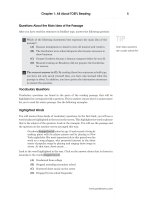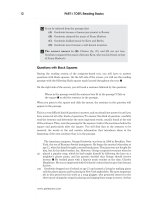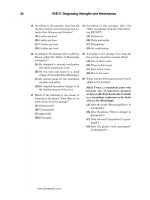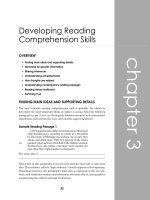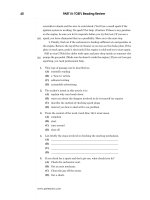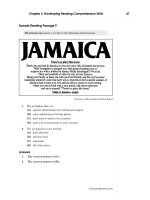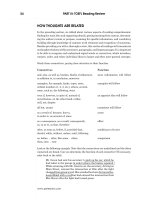Peterson’s master toefl reading skills part 19 pptx
Bạn đang xem bản rút gọn của tài liệu. Xem và tải ngay bản đầy đủ của tài liệu tại đây (90.35 KB, 7 trang )
Practice Test 2 117
practice test 2
www.petersons.com
45. Where can the following sentence be added
to the passage?
In fact, many harbors were burned
down from fires begun as a result of
ships’ colliding in port.
(A) After the word “encountered” in para-
graph 1
(B) At the end of paragraph 2
(C) After the word “third” in paragraph 3
(D) After the word “possibility” in para-
graph 4
46. How are ships kept apart in the ports of
Hamburg and New York?
(A) The port controllers guide ship cap-
tains by radio.
(B) Incoming and outgoing ships are as-
signed to clearly marked lanes.
(C) Ships are not allowed to change their
course or their speed while in port.
(D) Captains use their journals to deter-
mine the hazards in port.
47. What does the author imply about the
speed of jet airplanes?
(A) Air traffic is now safer than it was
with planes with piston-driven en-
gines.
(B) Radio communication between ships
and planes help schedules.
(C) Collisions of jet airplanes almost al-
ways result in the deaths of passen-
gers and crew.
(D) Pilots are now able to predict evasive
maneuvers that others will take.
48. What can be inferred about fuel consump-
tion in the nineteenth century?
(A) A ship’s captain had to decide how
many sails would be used on a ship.
(B) A navigator had to determine how
much fuel a ship needed for a voyage.
(C) A large amount of fuel made room for
extra cargo space.
(D) A journal was kept about the amount
of coal a steam engine used during a
voyage.
49. Look at the word “timetable” in the last
sentence of the passage. Which of the
following words has the same meaning?
(A) Schedule
(B) Network
(C) Navigation
(D) Established
50. Which of the following statements is sup-
ported by the passage?
(A) Information in mariners’ journals is
better than modern navigation tech-
niques.
(B) Collisions in the air are more danger-
ous than those at sea.
(C) Mariners today have to compute more
things than those in the past did.
(D) Air traffic controllers use the same
navigation techniques as sea captains.
05_TOEFL Reading,Ch4,105- 120 7/29/06, 12:02117
118 PART IV: Two Practice Tests
www.petersons.com
ANSWER KEY AND EXPLANATIONS
1. B 11. A 21. A 31. D 41. D
2. C 12. C 22. C 32. D 42. A
3. C 13. C 23. B 33. C 43. B
4. C 14. D 24. B 34. B 44. A
5. C 15. B 25. C 35. A 45. C
6. C 16. A 26. C 36. A 46. B
7. C 17. A 27. D 37. C 47. C
8. B 18. D 28. A 38. C 48. B
9. B 19. C 29. C 39. C 49. A
10. B 20. B 30. D 40. C 50. C
1. The correct answer is (B). Adorning means
“making beautiful” or “adding decorations
to.” Taking is the opposite of donating. Dis-
tributing is similar to donating but means
“giving the same amount to more than two
people.”
2. The correct answer is (C). It refers to “a
pint of whole blood.” The whole phrase is
necessary for the rest of the sentence to be
understood. All other answer choices are plu-
ral; it is singular.
3. The correct answer is (C). The last sen-
tence of paragraph 1 is, “People can donate
blood [for red blood cells] about once every
two months.”
4. The correct answer is (C). The sentence
fits best in the third paragraph, after the first
sentence. The paragraph is about what hap-
pens to the person who receives the blood.
That person is a recipient or a patient.
5. The correct answer is (C). The sentence is
as follows: “The blood flows through a plastic
tube to a collection bag or bottle that contains
sodium citrate, which prevents the blood from
clotting.”
6. The correct answer is (C). “Air bubbles in
the blood” is not a reaction to a transfusion. It
is a cause of a negative reaction.
7. The correct answer is (C). Undetected
means “not discovered” or “not realized.” In
the sentence, the other answer choices are
incorrect.
8. The correct answer is (B). The correct
word is rigorously.
9. The correct answer is (B). In the fifth para-
graph, it is stated that blood is irradiated when
the recipient is a newborn or an infant. To
radiate means to treat with radiant energy.
10. The correct answer is (B). None of the
other answer choices are stated or implied in
the passage.
11. The correct answer is (A). The other an-
swer choices use countries and dates men-
tioned in the passage but in an incorrect way.
12. The correct answer is (C). The first name
of Duncan’s father is neither mentioned nor
implied. Duncan did not work in Scotland. He
worked after he came to America. Duncan
Phyfe employed 100 craftsmen, but the pas-
sage does not say how many kinds of tables
his workshop made.
13. The correct answer is (C). “He was a quiet-
living, God-fearing young man who felt his
new name would probably appeal to potential
customers who were definitely anti-British in
this post–Revolutionary War period.” In para-
graph 2, this is the only sentence about his
name change.
14. The correct answer is (D). Phyfe did not
put his spelling, his chair, or his French on a
sign over his door stoop.
15. The correct answer is (B). As the word was
used in the fourth paragraph, it refers to the
organizations that trained craftsmen for a
variety of work. Guilds also controlled who
could work in a particular craft and stood for
high standards. As the word was used in the
05_TOEFL Reading,Ch4,105- 120 7/29/06, 12:02118
Practice Test 2 119
answers
www.petersons.com
practice test 2
fourth paragraph, trials are not mentioned.
The verdict of a jury may be “Guilty” but
never “guild.” As the word was used in the
fourth paragraph, it does not refer to émigrés,
political parties, or clubs.
16. The correct answer is (A). No longer re-
stricted is the correct phrase.
17. The correct answer is (A). The sentence
best fits in the fifth paragraph after the follow-
ing sentence: “What his workshop produced
shows Phyfe’s absolute dedication to quality in
workmanship.” The inserted sentence tells the
reader about the results of Phyfe’s dedication
to quality in workmanship.
18. The correct answer is (D). In paragraph 5,
the last sentence reports that Phyfe spent a
lot of money on materials.
19. The correct answer is (C). Paragraph 2
tells the reader that Phyfe began his work as
a joiner in 1792, in the late eighteenth cen-
tury. Paragraph 6 tells us he interpreted
European design in the late eighteenth and
early nineteenth centuries.
20. The correct answer is (B). The last para-
graph says that few pieces of Phyfe’s work
have been found, but they do exist (“are ex-
tant”). His furniture was not ignored; it was
popular. His father did not work for him.
21. The correct answer is (A). The emperors,
weapons, and social status are mentioned in
the passage, but they are only part of the
main topic, not the main topic itself.
22. The correct answer is (C). See the third
sentence of the first paragraph.
23. The correct answer is (B). See paragraph
2, first sentence.
24. The correct answer is (B). Spectacles some-
times means the same thing as eyeglasses but
not in this passage. The other two words are
distractors that have no connection to the
meaning of the word spectacle.
25. The correct answer is (C). They is a plural
pronoun, which has to refer to a plural noun.
The plural noun in the preceding sentence is
Thracians.
26. The correct answer is (C). A tunic is an
article of clothing, not a weapon.
27. The correct answer is (D). This sentence
would best fit the passage at the end of para-
graph 4. It adds information about the previ-
ous sentence that mentions the emperor
Commodus.
28. The correct answer is (A). The other an-
swer choices are not related to the meaning of
the word as it is used in the last sentence of
paragraph 3.
29. The correct answer is (C). See the second
sentence of paragraph 5. Gladiators could not
become emperors. Although Commodus
fought gladiators, no other emperor did so.
The passage does not mention whether em-
perors fought on horseback.
30. The correct answer is (D). The sentence
best fits in paragraph 5, after the second
sentence. Some refers to gladiators who had
been freed from gladiatorial service.
31. The correct answer is (D). Only the em-
peror could enter any section at will. See the
last sentence of paragraph 1.
32. The correct answer is (D). See sentence 2
in paragraph 1.
33. The correct answer is (C). The first sen-
tence of the second paragraph tells the reader
that Chinese architects did not borrow ideas
from any other country. The first sentence of
the third paragraph tells the reader how im-
portant the design was. Paragraph 4 tells the
reader to enter through the Meridian Gate.
34. The correct answer is (B). Unparalleled is
not related in meaning to parallel. The last two
answer choices are distractors that contain
words, but incorrect ideas, from the passage.
35. The correct answer is (A). Its refers to
UNESCO.
36. The correct answer is (A). The fourth para-
graph tells the reader about the gate and its
two auxiliary walls.
37. The correct answer is (C). All other choices
are distracters that incorrectly define the
word proclamations.
38. The correct answer is (C). White marble
bridges are found in the courtyard behind the
Meridian gate. See the second sentence of
paragraph 5.
05_TOEFL Reading,Ch4,105- 120 7/29/06, 12:02119
120 PART IV: Two Practice Tests
www.petersons.com
39. The correct answer is (C). See the fifth
paragraph of the passage.
40. The correct answer is (C). The other three
choices are distracters that are not related in
meaning to the correct answer.
41. The correct answer is (D). The three other
choices are mentioned or implied in the pas-
sage, but the main topic includes these ideas.
42. The correct answer is (A). Safe seaports
are not hazards. Whales and large fish could
be a hazard but are not as close in meaning to
hazards as dangerous obstacles. Inaccurate is
a distractor that is not related to the meaning
of the word in context.
43. The correct answer is (B). The correct
phrase is running into other vessels.
44. The correct answer is (A). The correct
word is ship.
45. The correct answer is (C). The sentence
best fits in paragraph 3, after the second
sentence. This sentence reports the results of
two ships colliding in a harbor.
46. The correct answer is (B). See the third
sentence in paragraph 3.
47. The correct answer is (C). See the first
sentence of paragraph 4.
48. The correct answer is (B). See the first
sentence of paragraph 5.
49. The correct answer is (A).
50. The correct answer is (C). The passage
reports how navigation became more com-
plex over time.
05_TOEFL Reading,Ch4,105- 120 7/29/06, 12:02120
answer sheet
www.petersons.com
Practice Test 3 121
✁
ANSWER SHEET PRACTICE TEST 3
06_TOEFL Reading,Ch 4,121-134 7/29/06, 12:03121
06_TOEFL Reading,Ch 4,121-134 7/29/06, 12:03122
123
practice test 3
Practice Test 3
Directions: Each passage is followed by a series of questions. Answer the
questions based on the information you gathered from the passage. Choose the best
answer to each question and answer each question based on what is stated or
implied in the passage.
QUESTIONS 1–10 REFER TO THE FOLLOWING
PASSAGE.
Jonas Salk is the American physician
and medical researcher who developed
the first safe and effective vaccine for
poliomyelitis. Salk received his M.D. in
1939 from New York University College
of Medicine, where he worked with Tho-
mas Francis Jr., who was studying how
to develop vaccines from killed viruses.
Salk joined Francis in 1942 at the Uni-
versity of Michigan School of Public
Health and became part of a group that
was working to develop a vaccine against
influenza.
In 1947, Salk became associate profes-
sor of bacteriology and head of the Virus
Research Laboratory at the University
of Pittsburgh School of Medicine, where
he began research on poliomyelitis.
Working with scientists from other uni-
versities in a program to classify the
various strains of the polio virus, Salk
corroborated other studies in identify-
ing three separate strains. He then dem-
onstrated that killed virus of each of the
three, although incapable of producing
the disease, could induce antibody for-
mation in monkeys.
In 1952, he conducted field tests of his
killed-virus vaccine, first on children
who had recovered from polio and then
on subjects who had not had the disease.
The results of both tests showed that the
children’s antibody levels rose signifi-
cantly and no subjects contracted polio
from the vaccine. His findings were pub-
lished the following year in the Journal
of the American Medical Association. In
1954, a mass field trial was held, and the
vaccine, injected by needle, was found to
safely reduce the incidence of polio. On
April 12, 1955, the vaccinewas released
for use in the United States.
Salk served successively as professor
of bacteriology, preventive medicine, and
experimental medicine at Pittsburgh,
and in 1963, he became fellow and direc-
tor of the Institute for Biological Studies
in San Diego, California, later called the
Salk Institute. Among many other hon-
ors, he was awarded the Presidential
Medal of Freedom in 1977.
1. What is the main idea of the passage?
(A) How Jonas Salk trained to be a physi-
cian and medical researcher
(B) How the medical research of Jonas
Salk led to the development of the
polio vaccine
(C) How Salk and his colleagues learned
to kill viruses
(D) How Salk was promoted to important
positions at the University of Penn-
sylvania
(5)
(10)
(15)
(20)
(25)
(30)
(35)
(40)
(45)
(50)
06_TOEFL Reading,Ch 4,121-134 7/29/06, 12:03123


